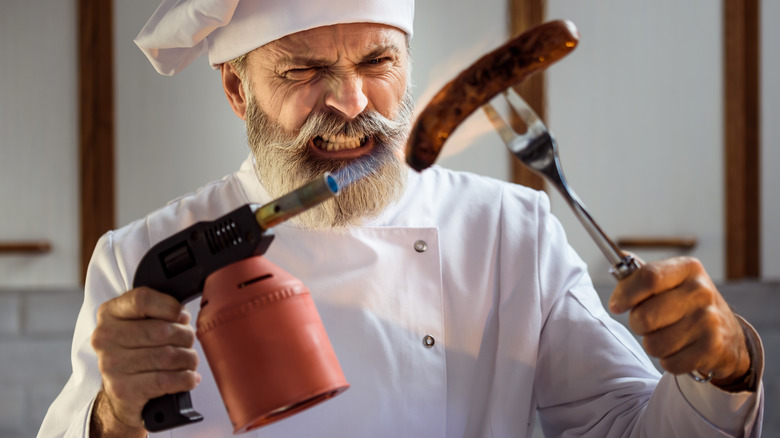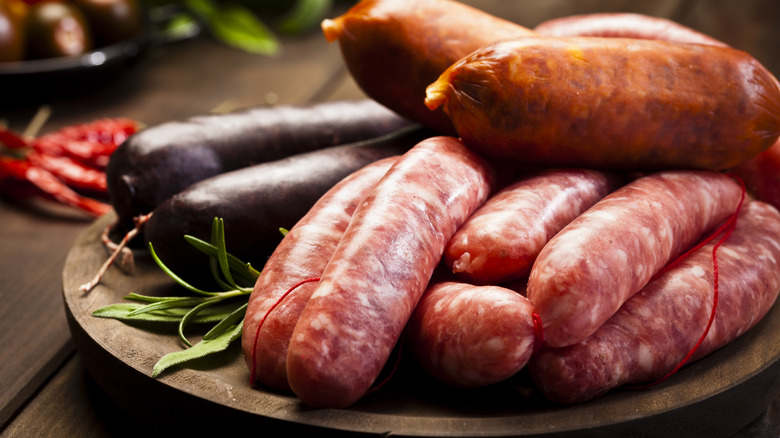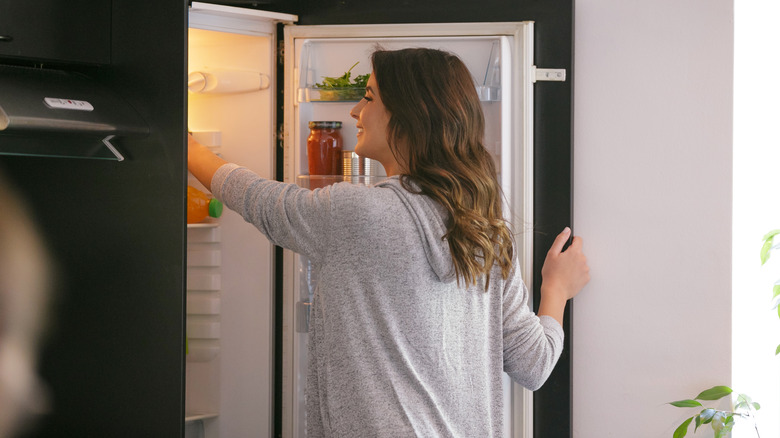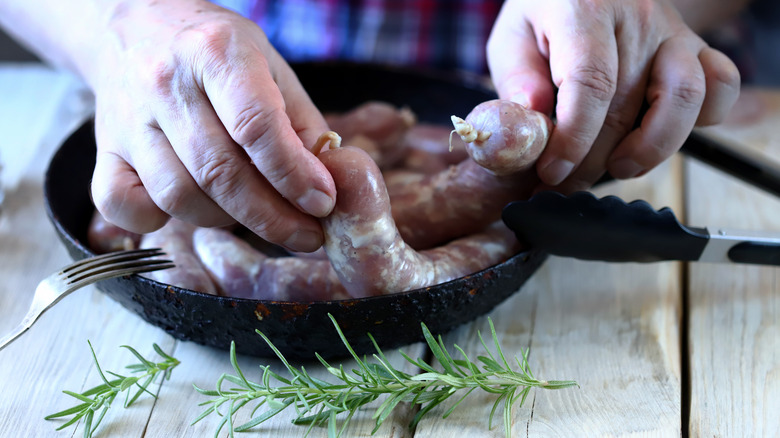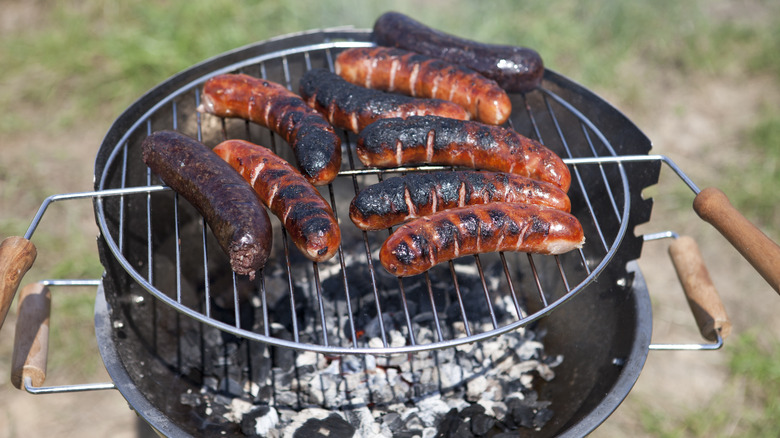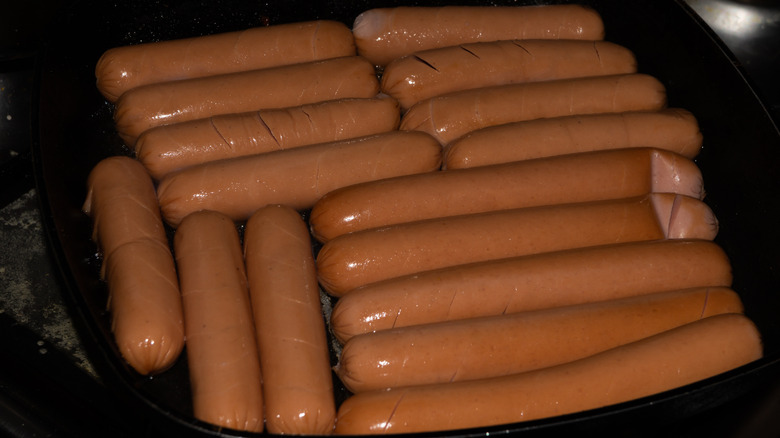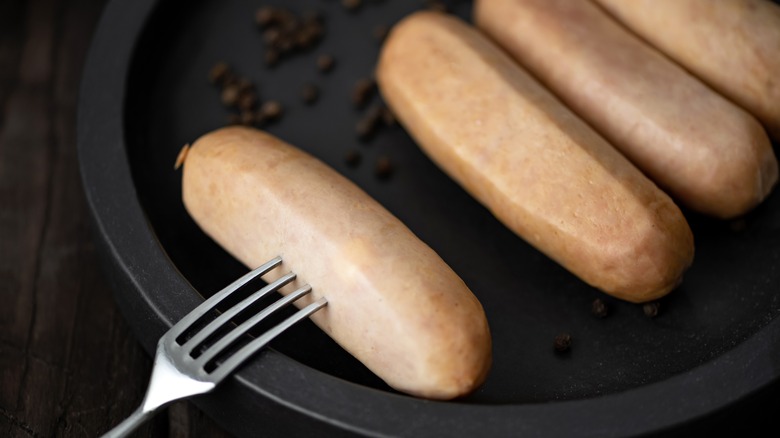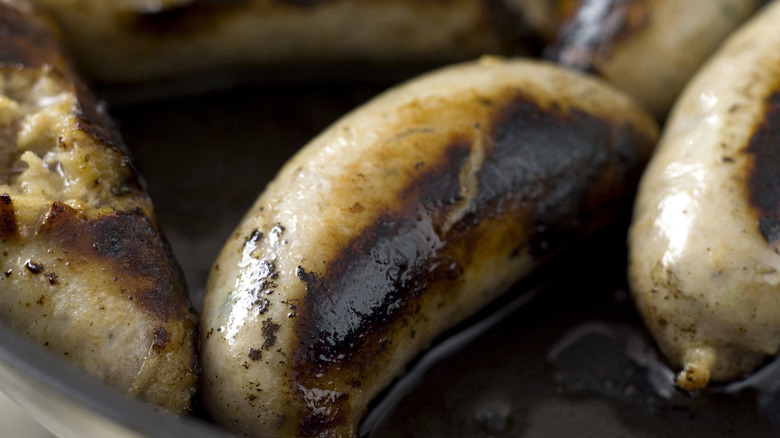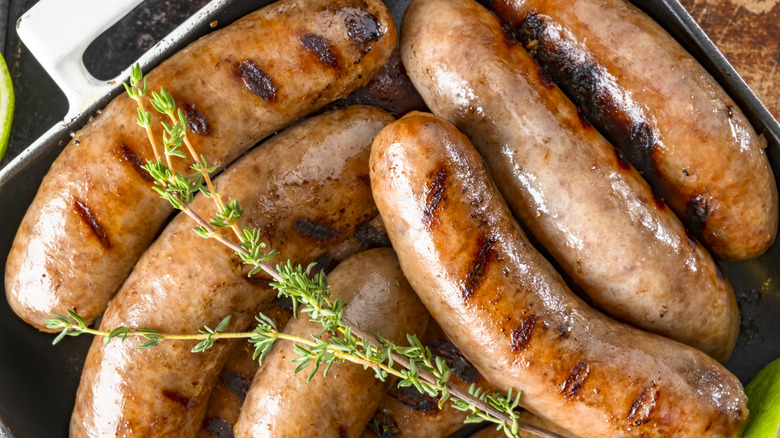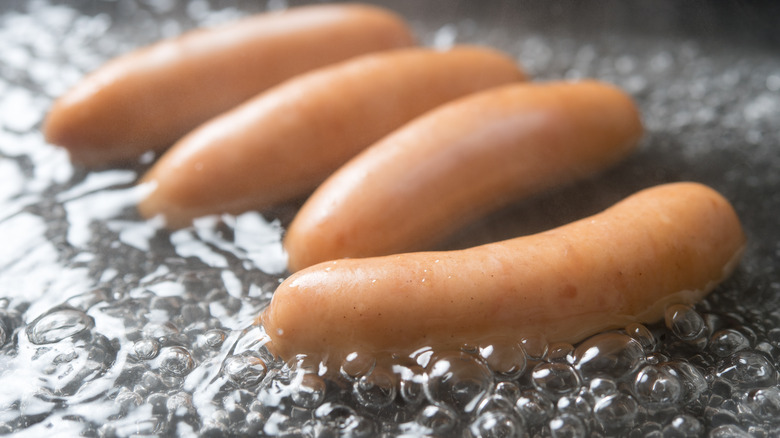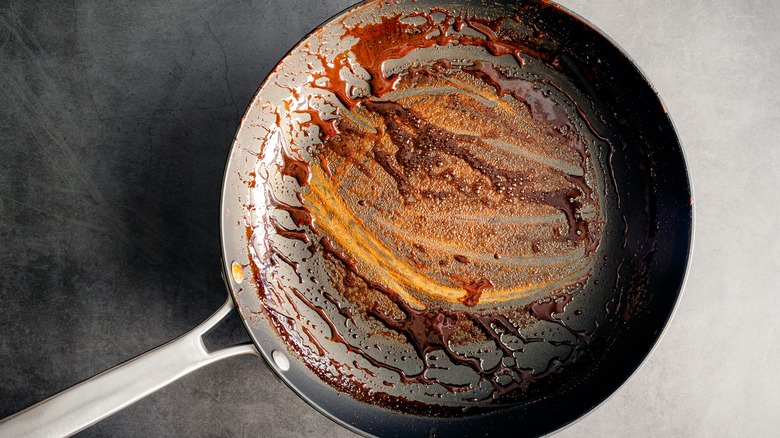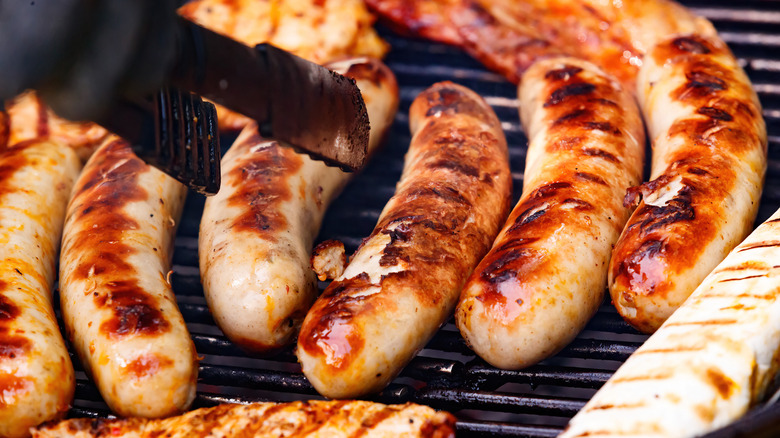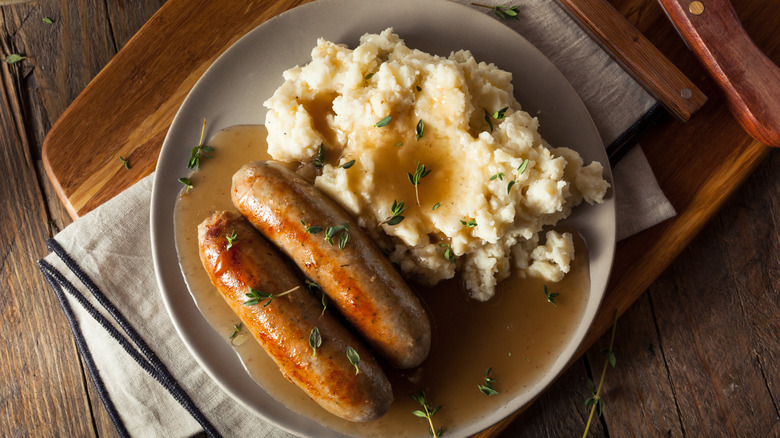12 Common Mistakes You Might Be Making When Cooking Sausage
Something about the simplicity of a good sausage is so intensely satisfying. Whether it's the iconic bangers and mash of England, German bratwurst on a bed of sauerkraut, or the American classic, the quintessential hot dog, we have developed a lasting affair with these indulging links of minced meat. No wonder sausages have become a staple in almost every household — they're perfect for those hectic weeknights when cooking seems like a daunting task. But here's the twist: Even the most ardent sausage lovers can fall prey to common cooking mistakes that hinder the full potential of what could be the most effortless meal.
Most sausages come seasoned, so you don't have to worry about extra work at home. Just toss them in a pan (or, better, grill) and let them cook away — the skins will blister before reaching caramel brown, while the fat inside will slowly render and turn it into a nose-tickling umami bomb. Sounds simple. A fact is that with so many varieties of sausages available, it takes a lot of work just to keep track of how to cook each — hence the mistakes. Luckily, we've done all the hard work for you and found all those little errors that might be stopping you from cooking the best sausages. The good news: It's super easy to fix them.
1. Not paying attention to the type of sausages you have
The leading mistake people make when cooking sausages is treating them all the same way. Different sausages require different preparation methods to bring out their best qualities. To simplify, we'll split them into two categories: fresh and ready-to-eat. Fresh sausages are made from raw meat and must be cooked well before serving. On the other side, ready-to-eat sausages, whether cooked (parboiled), cured, or smoked, can be eaten straight out of the package — we are not suggesting it, but you won't get food poisoning if you do it.
With the fresh sausages, it's always best to grill them or fry them on the pan. If you have a broiler, that works, too. You'll have to be gentle and patient — you want to brown them slowly until the inside of the sausage is fully cooked. It may take between 15 to 25 minutes, depending on thickness. You can put a lid over them to steam them off near the end. If you use the grill, closing the hood will do the trick.
With all the pre-cooked types of sausages, like a smoky knackwurst or frankfurter, you want to create a nice layer of caramelization on their casing without charring them into the blackness of the night. Keep turning them regularly until they're nice and brown — it shouldn't take you longer than 8 to 10 minutes.
2. Cooking sausages straight from the fridge
If you are still cooking sausages straight from the fridge, it may be why you're not getting the results you want. With all the time constraints, it may be tempting to toss cold sausages directly into the pan, but when you subject those chilly links to the heat, they suffer from a slow and uneven temperature distribution. The cold sausages will always take longer to cook through, often leading to a charred casing way before the interior is safe to eat.
The easy workaround is to let your fresh sausages cozy up at room temperature for 15 to 20 minutes before cooking. No matter how painful it may seem (who on earth has time for it these days?), this short wait is a proven way to ensure the sausages cook more evenly. Whether you're dealing with plump bratwursts or fresh Italian sausages, they all benefit from a brief warming period. The only exception is if you plan to simmer them in liquid, such as a broth, beer, or wine. In this case, you can start with cold sausages in a cold liquid and bring them to a gentle boil together.
3. Adding the sausage to a cold pan
To ensure your sausages are cooked perfectly every time, it's best to avoid adding them to a cold pan. Sausages have a delicate casing that helps them retain their moisture and shape. If you add them to a cold pan, the casing might stick to the surface and tear when you try to move them. This leads to the loss of juices and fat, which can make your sausages dry and tough. If you leave them for longer, you risk losing the shape that the casing provides altogether.
To cook sausages the right way, always start by heating a pan over medium-high heat. You can use a small amount of oil or butter to prevent sticking, but be careful not to use too much, as the meat will release enough extra fat when cooking. Add the sausages to the hot pan and let them cook undisturbed for a couple of minutes until they develop a golden brown crust on one side. Then, flip them over and continue the routine until they are evenly browned.
4. Using too-high heat
Whenever you crank up the heat in pursuit of a speedy meal, you can unwittingly sabotage it, only to end up with a charred, dry disaster on your plate. Most sausages are made of a mixture of ground meat and fat, held together by a casing. When you expose them to high heat, the fat melts, and the casing shrinks, causing them to burst or split open. Not only does this make them look rather ugly, but it also lets all the juices and flavor escape, leaving your sausages dry with crispy burnt casing on the outside.
So, what is too hot when it comes to cooking sausages? The answer depends on the type, size, and cooking method you use. However, a general rule of thumb is to keep the temperature between medium-low and medium-high, or around 160 to 180 degrees Fahrenheit. This will ensure that your sausages cook evenly and retain moisture and flavor inside.
5. Overcrowding the pan
We know it can be tempting to cram as many sausages as possible in the pan, especially if you're feeding an impatient crowd. However, it is not the best idea as it prevents them from cooking evenly — risky if you're cooking fresh sausages. Uneven cooking is a sure way to end up with raw patches of meat, which will surely ruin your dinner. Also, when you pack them in too tightly, they end up steaming instead of frying, leaving you with pale and flabby sausages that just don't hit the spot.
If you don't give enough "personal space" for your sausages, you will have trouble moving them around. A good rule of thumb is to leave at least 1/2 inch between each sausage. This gives them enough room for the heat to circulate around them and for the fat to render out. If you have too many sausages to cook, it's much better to do them in batches.
6. Pricking the sausage casings
Whether you pick a spicy Italian sausage, a German bratwurst, or a classic British banger, each has one thing in common: the casing that keeps the meat inside. Made from animal intestines or synthetic materials, this protective layer serves as a barrier that holds all the juiciness inside the sausage while it cooks. So, next time you're thinking about pricking the casing, remember this: The juices from the fat give the meat most of its flavor, so the last thing you want to do is to let them all out.
When you pierce the sausages, you create weak spots that allow the pressure to escape and deform them. Pricking the casings will also make the sausages shrink and curl up. Finally, if you cook them on a grill or a broiler, poking holes in the casing will increase the risk of flare-ups and burns.
There is an exception to the rule, however. If you're working with sausages that are extremely high in fat (anything around 50%), like some pork sausages, and you're worried about them bursting, you can try making a few shallow pricks. Make them as small as you can to preserve as much of the juices as possible. For any other type of sausage, you should stick to slow, uniform heat instead.
7. Overcooking the sausage
When cooking sausages, achieving the perfect level of doneness can be the difference between a succulent, juicy sausage and a dry piece of meat that even your dog refuses to eat. Overcooking causes meat proteins to tighten, resulting in a tough and sad-looking link — the only thing worse than that is if you burn it.
Whether you're grilling, pan-frying, or baking your sausages, maintaining medium to medium-low heat is key. Slow and steady wins the race here. Smoked or cooked sausages, such as bratwurst, only need to be heated for 8 to 10 minutes. On the other hand, fresh sausages typically need at least 15 to 25 minutes of cooking time, depending on the size.
To ensure that your sausage is perfectly cooked, it's best to check the internal temperature with a meat thermometer. Keep in mind that ground beef and pork should have an internal temperature of 160 degrees Fahrenheit, while ground chicken should be cooked at 165 degrees Fahrenheit, regardless of the cooking method. If you don't have a thermometer, try poking a small hole to see if the juices run clear. Cooked sausage should feel firm to the touch, but gauging it this way may take some practice.
8. Not resting the sausages after cooking
If you cut into a sausage right after cooking, you'll lose a lot of the juices and end up with a dry and bland link, something that many people still do when cooking fresh sausages. If you're not doing it yet, try resting it next time — patience goes a long way here. Resting the cooked sausage for a few minutes before serving allows the juices and flavors to redistribute evenly throughout the meat, making it more tender and moist.
How long should you rest your sausages? Ideally, you should do so for about the same time you cooked them. So, if you cooked your sausages for 10 to 12 minutes, you should rest them for another 10 to 12 minutes. This will ensure that they are perfectly juicy. You can rest them on a plate or a cutting board, covered loosely with foil or a lid to keep them warm. Remember, this only really applies to fresh sausages. You can enjoy pre-cooked, smoked, or cured sausages right away; they won't lose much juice or flavor even if you don't rest them.
9. Boiling sausage
You can pan-fry, roast, grill, or even braise sausages in the oven, but there is one method that you should stay away from — boiling. Boiling sausages may seem like a quick and easy way to cook them, but plunging your precious links into the water is actually not the best idea. Sausages are meant to be juicy and packed with character, and boiling them strips away their personality, leaving behind a bland, rubbery piece of meat, not to mention the scary pale appearance they will have.
You can get creative and poach your sausages in a flavorful, meaty broth or beer instead; however, you should still caramelize them before plunging them into any liquid. Frankfurters, often referred to as "hot dogs" and similar pre-cooked sausages, are the only sausages that can endure a quick boil without losing most of their quality. Even then, steaming them will get you much better results.
10. Not using the juices from the pan
When it comes to sauces for sausages, ketchup and mustard are ultimate favorites, but with a little extra effort, you can whip up something way more satisfying than a store-bought condiment. Next time you cook a batch of sausages, remember to make the most of those savory, rich juices from the pan. Those brown bits, known as fond, and drippings are full of flavor and can be turned into a delicious gravy, pan sauce, or liquid for braising.
Gravy is a classic accompaniment for sausages, especially when served with mashed potatoes. To make a simple one, keep the grease in the skillet after browning the meat. Sprinkle some flour over the mixture and cook for a few minutes, stirring constantly. This will create a roux (a classic French sauce foundation) that will thicken the gravy. Gradually whisk in some milk (or cream) until you reach your desired consistency. Season with salt, pepper, and some herbs, if you like, before returning the sausages to the pan.
If you're looking for a sauce with more finesse, a pan sauce is the way to go. After removing the sausages, deglaze the pan by adding a liquid like wine, broth, or even a splash of beer. Scrape up all those tasty browned bits from the bottom of the pan –- they are the most important. Let the liquid reduce by half, then whisk in a pat of butter for a glossy finish.
11. Not turning the sausages frequently
Another common mistake everyone makes when cooking sausage is not turning them frequently enough. Whether pan frying or grilling the links, you need to keep an eye on them and flip them regularly to ensure even browning.
Turning them often helps to distribute the heat and moisture evenly and prevent them from sticking to the pan or grill. If you don't do that, the casing can burst if exposed to high heat for a prolonged time. Turning them frequently helps prevent this and keeps the juices and flavor inside.
A general rule of thumb is to turn them every few minutes or about four to five times during the total cooking time. When pan-frying sausages, aim to turn them every 2 to 3 minutes. This will allow for even cooking and ensures a beautiful, lightly brown crust. The heat is often more intense on the grill, so stick to a couple of minutes per side. The round shape of the sausage makes the browning a little more difficult, so you might need to hold them down with tongs to get those awkward bits colored as well.
12. Not pairing sausages with the right sides
Since sausages are a relatively simple dish, pairing them with the right sides is absolutely essential. They are meaty, juicy (if cooked right), and mostly fatty (with the exception of turkey or chicken). While you can't go wrong with a side of mash and a spoonful of gravy with your sausages, there are a few rather odd pairings that are not exactly the best to throw in with your wiener.
Most starches like rice or quinoa don't do justice to the sausage unless you serve them with spicy chorizo or a smoky Italian beef sausage. Picking something less grainy usually creates a much better mouthfeel overall — potatoes (in all of their forms), pasta, or any root vegetables most often will be a better fit.
Mayonnaise is yet another odd combination to add to your sausages. If you try to marry it with the fattiness of the meat, it always comes across as a little heavy on the palate. So, if you're making a coleslaw, go heavier on the yogurt. The acidity will help cut through the fat while adding brightness to your meal. And if you're cooking lamb sausages, don't forget to chop some fresh mint in there, too.
